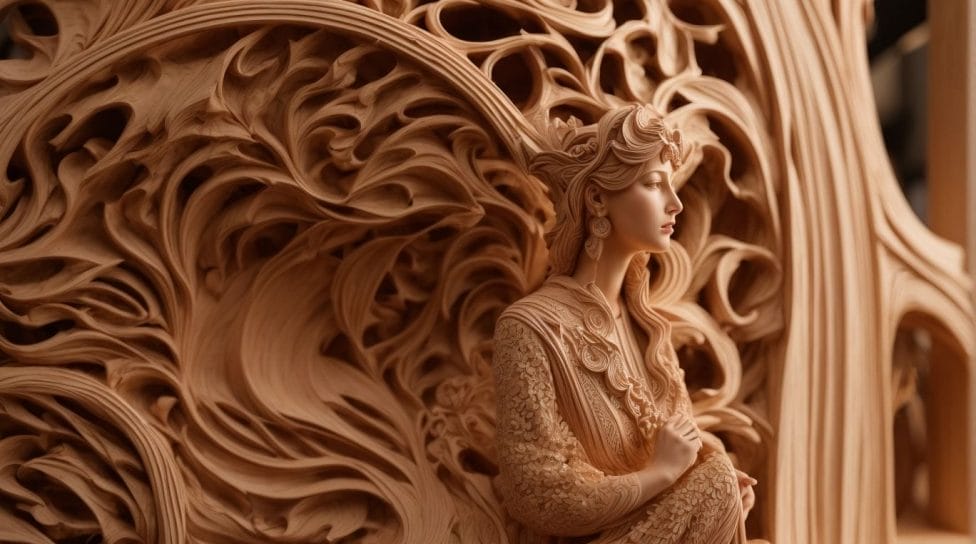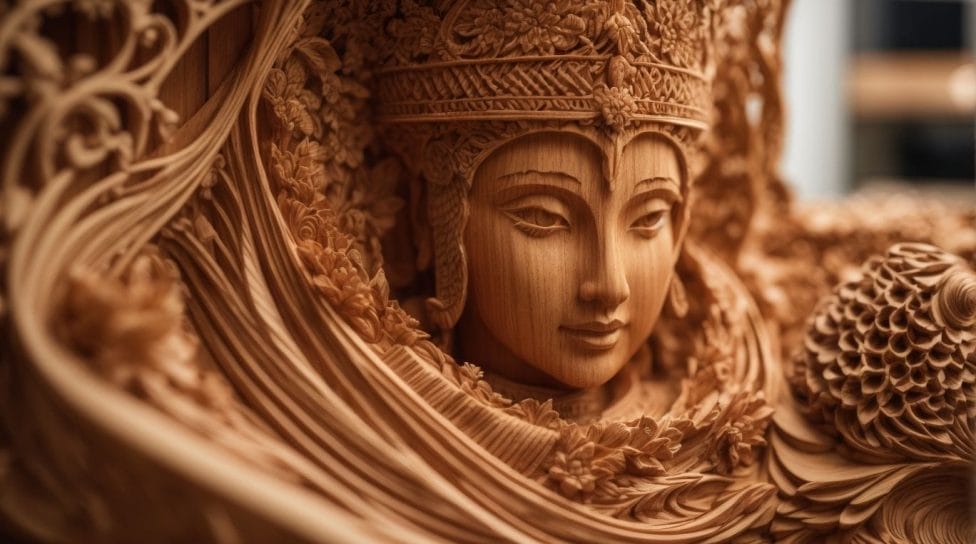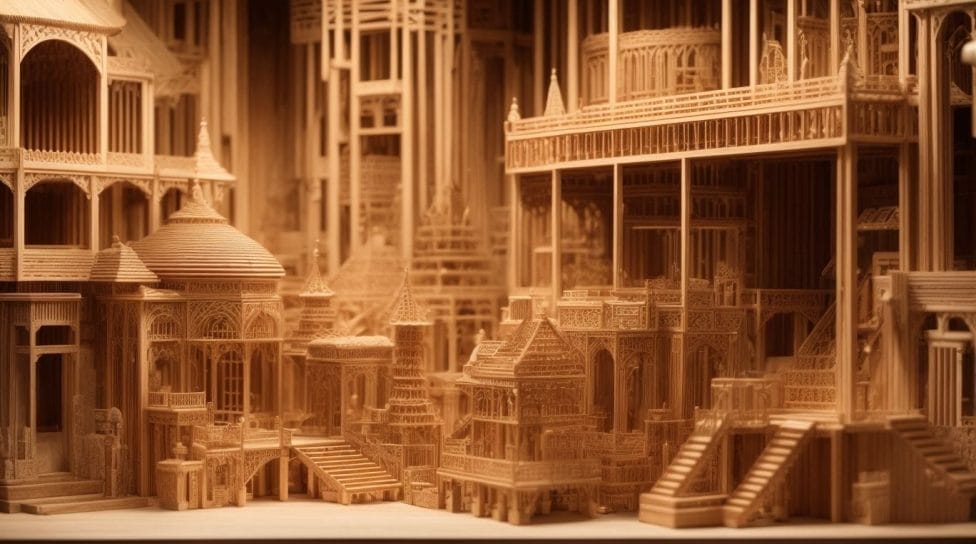3D printing has revolutionized the manufacturing industry by allowing the creation of intricate and customized objects. While 3D printing with plastic materials is well-known, there is growing interest in 3D printing with wood. But is it possible to create a 3D print with wood? In this article, we will explore the fascinating world of 3D printing with wood and delve into its benefits, challenges, limitations, and various applications.
What is 3D Printing with Wood?
3D printing with wood involves using wood-based filaments to create three-dimensional objects layer by layer through additive manufacturing. The resulting objects have a natural wood-like appearance, with unique textures and grain patterns that resemble real wood.
How Does 3D Printing with Wood Work?
3D printing with wood begins with creating a digital design using CAD (Computer-Aided Design) software. The design is then converted into instructions that the 3D printer can understand. During printing, the wood-based filament is heated and extruded onto a build plate in precise layers, gradually forming the desired object.
Benefits and Advantages of 3D Printing with Wood
1. Sustainability and Environmental Friendliness – 3D printing with wood offers a more sustainable alternative to traditional manufacturing methods, utilizing biodegradable and renewable materials.
2. Aesthetics and Natural Look – Wood 3D printed objects have a unique and pleasing aesthetic, making them ideal for decorative and artistic purposes.
3. Unique Textures and Grain Patterns – One of the standout features of 3D-printed wood objects is the ability to replicate the intricate textures and grain patterns in real wood.
4. Durability and Strength – Contrary to popular belief, 3D-printed wood objects can exhibit impressive strength and durability, making them suitable for functional applications.
Challenges and Limitations of 3D Printing with Wood
1. Limited Availability of Wood Filaments – Unlike plastic filaments, wood-based filaments are not as widely available, which can restrict the options for 3D printing with wood.
2. Difficulty Achieving Fine Details – Wood filaments are generally coarser than plastic filaments, making it challenging to achieve intricate fine details in 3D-printed wood objects.
3. Shrinkage and Warping – Wood filaments tend to shrink and warp during the printing process, affecting the dimensional accuracy of the final object.
4. Post-Processing Requirements – 3D printed wood objects often require additional post-processing, such as sanding or sealing, to enhance their appearance and ensure a smooth finish.
Applications of 3D Printing with Wood
The versatility of 3D printing with wood opens up various applications across different industries. Some notable applications include creating furniture and home decor items, architectural models, art sculptures, custom woodworking tools, and prototypes.
Key takeaways:
- 3D printing with wood is possible: Using specially formulated wood filaments, it is now possible to 3D print objects that have the look and feel of real wood.
- Benefits of 3D printing with wood: 3D-printed wood objects offer sustainability, natural aesthetics, unique textures, and durability, making them a versatile option for various industries.
- Challenges of 3D printing with wood: Limited availability of wood filaments, difficulty achieving fine details, shrinkage, warping, and post-processing requirements are some challenges to consider when 3D printing with wood.
What is 3D Printing with Wood?

Photo Credits: Futureproof3D.Com by Carl Moore
3D Printing with Wood
3D printing with wood involves utilizing a distinctive filament crafted from a blend of wood particles and a binding agent. This filament is loaded into a 3D printer, which then proceeds to melt and extrude the material to create objects layer by layer. The outcome is a product that emulates the appearance and texture of wood. This innovative technique enables the fabrication of intricate wooden designs and prototypes that may be challenging to achieve through traditional woodworking methods. It is crucial to note that the final product is not genuine wood but a composite material that closely resembles it.
How Does 3D Printing with Wood Work?
- How Does 3D Printing with Wood Work? Begin by designing a digital model of the object you want to print using computer-aided design (CAD) software.
- Slicing: The software divides the digital model into multiple thin layers, creating a printable file.
- Material Selection: Choose a wood filament specifically designed for 3D printing. These filaments consist of a mixture of wood fibers and a binding agent.
- Printing: The 3D printer heats the wood filament, extruding it layer by layer onto a build platform using a nozzle. The nozzle moves according to the instructions from the sliced file.
- Layer Bonding: As the wood filament is extruded, it cools and solidifies, creating a strong bond between layers.
- Finishing: Once the printing is complete, remove any support structures and sand the object to achieve a smooth surface and enhance its appearance.
Did you know that 3D printing with wood allows for the creation of unique and intricately designed wooden objects that would be challenging to achieve through traditional woodworking techniques?
Benefits and Advantages of 3D Printing with Wood

Photo Credits: Futureproof3D.Com by Austin Walker
Discover the marvels of 3D printing with wood and all the amazing benefits it brings. From its sustainability and environmental friendliness to the beautiful aesthetics and natural look it provides, 3D printing with wood opens up a world of possibilities. Experience unique textures and grain patterns like never before while also enjoying the durability and strength that this incredible material offers. Step into the realm of innovation and creativity with wood 3D printing!
Sustainability and Environmental Friendliness
Using wood for 3D printing offers numerous advantages in terms of sustainability and environmental friendliness:
- Reduced Waste: Wood filaments used in 3D printing are commonly derived from recycled wood or wood by-products, minimizing waste.
- Renewable Material: Wood is a renewable resource, making it an eco-friendly option for 3D printing.
- Lower Carbon Footprint: 3D printing with wood requires less energy compared to traditional woodworking methods, resulting in a reduced carbon footprint.
- Biodegradable: Wood-based filaments used in 3D printing are biodegradable, ensuring that discarded prints do not contribute to plastic waste.
Aesthetics and Natural Look
One of the main advantages of 3D printing with wood is the ability to achieve aesthetics and a natural look that is difficult to replicate with other materials. The following are some key aspects relating to the aesthetics and natural look of 3D-printed wood:
- Natural textures and grain patterns: 3D printing with wood allows for reproducing intricate textures and grain patterns found in real wood, giving the printed objects an authentic and organic appearance.
- Warm and earthy tones: Using wood filaments, 3D-printed objects can have warm and earthy tones, adding to their natural appeal.
- Enhanced visual appeal: The natural look of 3D-printed wood can enhance the visual aesthetics of objects, making them more attractive and unique.
There is a touching, true story about a woodworker who used 3D printing to recreate a cherished wooden toy for a child with special needs. The 3D-printed replica not only matched the aesthetics of the original toy but also provided a safe and durable alternative for the child to enjoy.
Unique Textures and Grain Patterns
One of the key benefits of 3D printing with wood is the ability to create objects with unique textures and grain patterns, bringing a natural and organic look to the final product.
- Natural Variation: Each piece of wood has its distinct grain pattern, resulting in a one-of-a-kind appearance for every printed object.
- Customization: With 3D printing, you can manipulate the design and orientation of the wood fibers, allowing for further customization of the texture and grain pattern.
- Replication of Traditional Woodworking Techniques: 3D printing can replicate the appearance of traditional woodworking techniques such as carving or woodturning, creating intricate textures and grain patterns.
- Enhanced Visual Appeal: The natural textures and grain patterns produced by 3D printing with wood can add depth and richness to artistic pieces and sculptures.
Durability and Strength
The durability and strength of 3D-printed objects made of wood are crucial considerations when utilizing this innovative technology. Here are several key aspects to note regarding the durability and strength of 3D printing with wood:
Material composition: Regarding 3D-printed wood objects, their strength and durability result from combining wood fibers and a binding agent.
Layer bonding: The layer-by-layer printing process ensures a robust final product by promoting strong adhesion between each layer.
Structural integrity: Wood-based filaments offer exceptional structural integrity, making them suitable for functional parts and objects that demand strength.
Post-processing: Techniques such as sanding, sealing, or varnishing can be applied during post-processing to enhance further the durability and strength of 3D-printed wood objects.
Applications: With its admirable durability and strength, 3D printed wood finds ideal usage in various applications such as furniture, home decor, architectural models, and custom woodworking tools.
Challenges and Limitations of 3D Printing with Wood

Photo Credits: Futureproof3D.Com by Christian Nguyen
Discover the world of 3D printing with wood and unravel the challenges and limitations. From the limited availability of wood filaments to the difficulty in achieving intricate details, shrinkage, warping, and post-processing requirements, we’ll explore the roadblocks in using wood in 3D printing. Brace yourself for an enlightening journey into the realities of 3D printing with wood, where innovation meets its share of obstacles.
Limited Availability of Wood Filaments
Challenges of 3D Printing with Wood Filaments
One of the major challenges faced in 3D printing with wood is the limited availability of wood filaments. Unlike PLA or ABS filaments, wood filaments are not as readily accessible.
- Supply: Wood filaments, due to their limited availability, are not as easily obtainable as other types of filaments, such as PLA or ABS.
- Compatibility: Another challenge is that wood filaments may not be compatible with all 3D printers, restricting the options for users who wish to utilize this material.
- Variety: Furthermore, there is a restricted range of wood species available in filament form, limiting the choice of textures and colors that users can achieve.
- Cost: Wood filaments tend to be more expensive compared to other filaments, thus making them less accessible for some users.
Fact: It is worth noting that as of 2021, wood filaments accounted for less than 10% of the total filament market. This statistic highlights the limited availability and adoption of wood filaments in the 3D printing industry.
Difficulty Achieving Fine Details
When it comes to 3D printing with wood, one of the difficulties is achieving fine details in the printed objects. The natural grain and texture of wood can present a challenge for the printer when it comes to accurately reproducing intricate designs. Wood filaments, compared to other materials, have larger particle sizes, which can restrict the level of detail that can be achieved. Additionally, wood filaments are prone to shrinkage and warping more than other filaments, which further impacts the precision of the final print. However, despite these challenges, 3D printing with wood still offers the opportunity to create custom woodworking tools and prototypes, showcasing the potential of this technology. It is important to note that wood 3D printing can produce objects with organic textures and natural variations, giving them an authentic and unique aesthetic.
Shrinkage and Warping
Shrinkage and warping are common challenges in 3D printing with wood due to the inherent properties of wood, such as moisture content and grain structure.
| Challenge | Description |
| Shrinkage | Wood filaments can experience shrinkage as they cool, resulting in dimensional inaccuracies in the printed object. |
| Warping | Uneven cooling can lead to warping, causing the corners or edges of the print to lift or curl. |
To mitigate these issues, various techniques can be employed, including adjusting the printing parameters, using a heated print bed, or implementing brims and rafts for better adhesion. Post-processing techniques like sanding and sealing can also contribute to improving the surface finish and reducing the effects of shrinkage and warping.
Post-Processing Requirements
- Post-processing requirements: Post-processing is an essential step in 3D printing with wood to achieve the desired finish and functionality of the printed objects. Here are the post-processing requirements to consider:
- Sanding: Wood filament often results in rough surfaces, so sanding is necessary to smoothen the object.
- Staining or Painting: To enhance the appearance, the printed wood object can be stained or painted in various colors.
- Coating: Applying a protective coating, such as varnish or lacquer, helps preserve the wood and gives it a polished look.
- Finishing touches: Adding details, like adding wood fillers for gaps or using wood veneer for realistic wood grain, can refine the final product.
These post-processing requirements contribute to achieving the desired aesthetics and functionality of 3D-printed objects with wood filament.
Furniture and Home Decor
3D printing with wood offers exciting possibilities for creating unique and customizable furniture and home decor pieces. Here are some applications:
- 3D-printed wood furniture and home decor can be designed to fit specific spaces or incorporate intricate designs that are difficult to achieve with traditional woodworking techniques.
- From decorative vases and lampshades to wall art and planters, 3D printing with wood allows for creating artistic and functional pieces that add a natural touch to any space.
- Customization: With 3D printing, it’s easy to personalize furniture and home decor items by incorporating names, quotes, or unique patterns.
- Prototyping: Designers and manufacturers can use 3D printing with wood to create prototypes of new furniture and home decor designs before committing to full-scale production.
Architectural Models
Architectural models created using 3D printing technology offer many benefits and possibilities for architects and designers. The precision provided by 3D printing allows for the creating of highly accurate and detailed architectural models, allowing architects to showcase their designs with unmatched precision. Moreover, printing architectural models with wood filaments can significantly enhance time and cost efficiency compared to traditional model-making methods.
One of the key advantages of 3D printing is its customizability. Architects can easily modify and iterate their designs, making it simpler to incorporate client feedback and make necessary adjustments. Additionally, architectural models printed with wood provide a visually appealing and realistic representation of the final design, aiding clients and stakeholders in visualizing the project effectively.
Furthermore, physical architectural models offer a level of tangibility that is not possible with digital renderings. By holding and examining a physical model, one can gain a better understanding of spatial relationships and proportions. This aspect enhances the overall comprehension and analysis of the design.
By incorporating 3D printing in architectural model-making, a broad range of creative possibilities opens up for architects. They can experiment with various designs, materials, and textures, thereby pushing the boundaries of traditional architectural practices. This technology can potentially revolutionize the field of architecture, significantly enhancing communication and presentation of architectural ideas.
Art and Sculptures
Creating art and sculptures through 3D printing with wood offers unique possibilities and advantages over traditional methods.
- Freedom of design: 3D printing allows for the creation of intricate and complex shapes that would be difficult to achieve through traditional woodworking techniques.
- Texture and grain patterns: Wood filaments can replicate the natural textures and grain patterns of different wood types, adding an authentic and organic aesthetic to the artwork.
- Customization: Artists can easily modify or personalize their designs, experimenting with different sizes, shapes, and details to bring their vision to life.
- Cost-effective: 3D printing reduces material waste, making it a more cost-effective option for creating large-scale sculptures.
Fact: The world’s largest 3D-printed wooden sculpture, measuring 12 meters tall, was created in Belgium in 2021.
Custom Woodworking Tools and Prototypes
Regarding custom woodworking tools and prototypes, 3D printing with wood presents unique opportunities. This innovative technology allows for intricate and customized designs, making it possible to create one-of-a-kind woodworking tools and prototypes.
One of the major benefits is that 3D printing with wood is cost-effective. Traditional methods of creating woodworking tools and prototypes can be both expensive and time-consuming. However, with 3D printing, the process becomes more affordable and efficient.
Moreover, 3D printing enables rapid prototyping. Designers can quickly iterate and test their prototypes, saving valuable time and resources in the development process.
Customization is another advantage of 3D printing. Woodworking tools can easily be customized to suit specific needs and preferences. This level of flexibility is highly beneficial for artisans and DIY enthusiasts.
Furthermore, wood-based filaments used in 3D printing balance strength and aesthetics. This makes them suitable for creating functional tools that are also visually appealing prototypes.
Some Facts About Can You 3D Print Wood?
- ✅ Wood 3D printing offers a more sustainable approach to using wood as a material. (Source: 3Dnatives)
- ✅ Extrusion and powder bed processes are the two main methods of wood 3D printing. (Source: 3Dnatives)
- ✅ Wood filament looks, feels, and smells like real wood, but it is more delicate and prone to breaking. (Source: 3Dnatives)
- ✅ Powder bed processes use a fine brown powder made of wood chips to create wooden parts. (Source: 3Dnatives)
- ✅ Wood 3D printing has the potential to revolutionize industries such as interior design, carpentry, and joinery. (Source: 3Dnatives)


